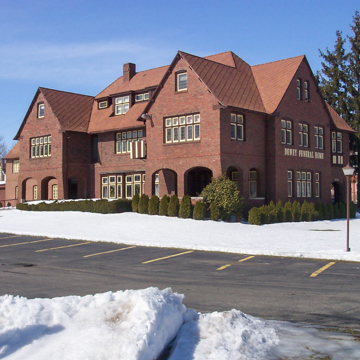You are here
Dewey Funeral Home (Francis and Louisa Yeomans King House, “The Orchard House”)
Located on Alma's finest residential street and surrounded by lovely gardens is this large eclectic house, designed by Heun, a member of the Steinway Group of Prairie School architects in Chicago. The large red brick house has intersecting gables and battered piers on its protected entranceways, all of which suggest medieval origins. The ribbon band windows, however, hint at the architect's Prairie School background. The house was added to in 1928 and 1967, and a central entrance was removed. Francis and Louisa Yeomans King came from Chicago to live in Alma in 1902, after a stay at the Alma Sanitarium. Francis King (b. 1863) was a banker and manufacturer who served as president of the Alma Board of Trade, as well as mayor of Alma in 1907–1908 and state senator in 1913. A horticulturist, Louisa Boyd Yeomans King (1863–1948) founded the Woman's National Farm and Garden Association, served as its president from 1914 to 1921, and wrote her famous gardening books, including A New Garden (1930).
Writing Credits
If SAH Archipedia has been useful to you, please consider supporting it.
SAH Archipedia tells the story of the United States through its buildings, landscapes, and cities. This freely available resource empowers the public with authoritative knowledge that deepens their understanding and appreciation of the built environment. But the Society of Architectural Historians, which created SAH Archipedia with University of Virginia Press, needs your support to maintain the high-caliber research, writing, photography, cartography, editing, design, and programming that make SAH Archipedia a trusted online resource available to all who value the history of place, heritage tourism, and learning.






